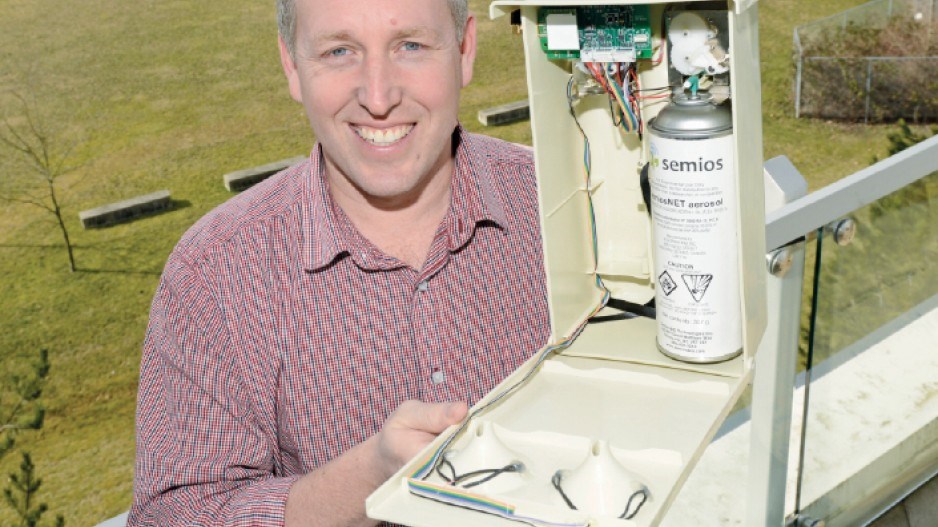When it comes to infestations, few insects are as problematic as bedbugs, which have made a dramatic comeback over the last decade.
The problem isn’t just that some of the most effective pesticides used to control them have been banned or that they have developed resistance to those that are still available.
The problem is where they hide: your bed, your sofa, your clothes. And no one wants the bed they sleep in or the clothes they wear treated with chemicals containing neurotoxins.
So it’s probably not surprising that two B.C. companies that have developed natural, non-toxic treatments for a whole range of insects started out by focusing on bedbugs.
Both Terramera Biosciences and SemiosBIO Technologies Inc. have developed natural pesticides based on compounds found in nature that are non-toxic to humans and animals. Both are busy developing pest control products for agriculture, and both initially focused on bedbugs.
Brett Johnston, owner of Assured Environmental Solutions Inc. – a Vancouver pest control company that got its start focusing solely on bedbugs – is anxious to get his hands on both companies’ products, neither of which is approved in Canada.
“I think it’s fantastic, and secondly I think, ‘Damn it, I wish they would register the product in Canada,’” he said.
U.S. regulators consider the bedbug epidemic so bad they fast-tracked approval of Terramera’s neem-oil-based product, Cirkil, which is now being used by exterminators in the U.S. Getting it approved for sale in Canada will take longer and be costlier, because the standards are higher here.
Meanwhile, Terramera is already turning its focus to another ripe market – agriculture – and so is SemiosBIO.
“Organic agriculture is one major additional area that we’re working on, and we’re getting a lot of interest,” said Terramera CEO Karn Manhas.
The agricultural pesticide market alone is worth $50 billion a year, according to SemiosBIO. One of the ripest markets is pest control for high-value crops such as apples, walnuts and grapes.
“We estimate that market to be worth just over $30 billion,” said SemiosBIO CEO Michael Gilbert.
SemiosBIO uses pheromones – chemicals that insects emit and detect to communicate with each other for things like mating – for pest control. Their use is not new. Contech Inc. – another B.C. company specializing in environmentally friendly pest control – has been using pheromone-based pest control for years.
But to date, a pheromone-based approach for bedbugs has yet to be developed and approved for sale. SemiosBIO’s first innovation was developing bedbug pheromones to either attract or repel bedbugs. The attractant can be used to trap bedbugs, while the repellent can be used to keep the bugs away.
Another innovation is its use of machine-to-machine technology to combat the codling moth in apple orchards.
When the female moth emits a pheromone, it attracts males so they can mate. Flood the orchard with a chemically synthesized pheromone, and the male moth can’t find the female, which prevents her from laying the eggs that hatch inside apples.
But most growers have to use a shotgun approach – spraying orchards every two weeks, or setting up hundreds of dispensers that continuously release the pheromone – both of which are labour-intensive, inefficient and costly.
With the help of wireless accelerator Wavefront, SemiosBIO developed a cloud-based system of wireless cameras that can detect and identify moths when they first appear and then automatically release pheromones only when and where needed.
The system is being tested in 65 orchards in Canada, the U.S., Italy and the Netherlands. In a trial in Italy last year, two test sites were compared to a control orchard that was sprayed with chemical pesticides.
“In our two treatment sites, we had zero counts of codling moths,” Gilbert said. “We had 0% damage from codling moth and they [the chemically treated orchard] had 0.5% damage, even though they had two sprays of pesticides.”
The SemiosBIO system is intended to reduce rather than eliminate chemical pesticide use in orchards.
“A grower can go from using 10 to 12 sprays a year down to one or two,” Gilbert said. “It’s not necessarily certified organic, but the amount of pesticides used is significantly reduced.”
Gilbert is hoping to get the system approved for use in Canada and the U.S. in time for the 2015 growing season.
Terramera is also working on using neem oil – a natural pesticide produced by the neem tree in India – to kill agricultural pests, including the varroa mite, which kills honeybees.
Deborah Henderson, director of the Institute for Sustainable Horticulture at Kwantlen Polytechnic University, said there is growing demand for non-toxic pesticides, especially in agriculture.
“We have pests that do have resistance issues that we’re running out of tools for,” she said. “We have other pests that don’t have the resistance issues, but the cost of the pesticide is very high. And there’s always a problem with contaminating groundwater.”
Her department is experimenting with a number of biopesticides – distinguished from “natural” pesticides like neem oil in that they are living organisms that kill other living organisms.
One is the baculovirus, which kills insects like caterpillars but is not harmful to humans or animals.
It is also researching a type of fungus that kills another type of fungus that causes root disease in crops.
She said biopesticides are still a largely untapped alternative to chemical pesticides.
“We have so many native biocontrols that we have not tapped into at all,” she said. “There’s no need to go and genetically modify anything.”




